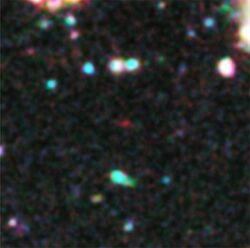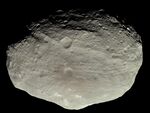Astronomy:UDFj-39546284
Coordinates: ![]() 03h 32m 39.54s, −27° 46′ 28.4″
03h 32m 39.54s, −27° 46′ 28.4″
| UDFj-39546284 | |
|---|---|
 Hubble Space Telescope image of UDFj-39546284 (seen as a reddish spot in the center of the image) | |
| Observation data (J2000 epoch) | |
| Constellation | Fornax |
| Right ascension | 03h 32m 39.54s[1] |
| Declination | −27° 46′ 28.5″[1] |
| Redshift | 11.58+0.05 −0.05[2] [3][4] |
| Apparent magnitude (V) | V fainter than 30.1[5] H160 = 28.92 ± 0.18[5] J125 – H160 > 2[5] |
| Other designations | |
| [MDB2013] UDF12-3954-6285, JADES-GS-z11-0 | |
UDFj-39546284 is a high-redshift Lyman-break galaxy discovered by the Hubble Space Telescope in infrared Hubble Ultra-Deep Field (HUDF) observations in 2009. The object, located in the Fornax constellation, was identified by G. Illingworth (UC Santa Cruz), R. Bouwens (UC Santa Cruz and Leiden University) and the HUDF09 Team during 2009 and 2010.[6][7] It was reported with a redshift of z~10 using Hubble and Spitzer Space Telescope photometric data,[3] with later reports in 2012 suggesting a possibly higher redshift of z = 11.9[8][3] Although doubts were raised that this galaxy could instead be a low-redshift interloper with extreme spectral emission lines producing the appearance of a very high redshift source,[4][3] later spectroscopic observations by the James Webb Space Telescope's NIRSpec instrument in 2022 confirmed the galaxy's high redshift to a spectroscopically confirmed estimate of z = 11.58.[2]
Gallery
See also
- EGSY8p7
- Hubble Ultra-Deep Field
- List of the most distant astronomical objects
- MACS0647-JD
- Reionization
- UDFy-38135539
References
- ↑ 1.0 1.1 "[MDB2013 UDF12-3954-6284"]. SIMBAD. Centre de données astronomiques de Strasbourg. http://simbad.u-strasbg.fr/simbad/sim-basic?Ident=%5BMDB2013%5D+UDF12-3954-6284.
- ↑ 2.0 2.1 Robertson, B. E. (2023). "Identification and properties of intense star-forming galaxies at redshifts z > 10". Nature Astronomy 7 (5): 611–621. doi:10.1038/s41550-023-01921-1.
- ↑ 3.0 3.1 3.2 3.3 Bouwens, R. J.; Oesch, P. A.; Illingworth, G. D.; Labbé, I.; Van Dokkum, P. G.; Brammer, G.; Magee, D.; Spitler, L. R. et al. (2013). "Photometric Constraints on the Redshift of z ~ 10 Candidate UDFj-39546284 from Deeper WFC3/IR+ACS+IRAC Observations over the HUDF". The Astrophysical Journal Letters 765 (1): L16. doi:10.1088/2041-8205/765/1/L16. Bibcode: 2013ApJ...765L..16B.
- ↑ 4.0 4.1 Brammer, Gabriel B.; Van Dokkum, Pieter G.; Illingworth, Garth D.; Bouwens, Rychard J.; Labbé, Ivo; Franx, Marijn; Momcheva, Ivelina; Oesch, Pascal A. (2013). "A Tentative Detection of an Emission Line at 1.6 μm for the z ~ 12 Candidate UDFj-39546284". The Astrophysical Journal Letters 765 (1): L2. doi:10.1088/2041-8205/765/1/L2. Bibcode: 2013ApJ...765L...2B.
- ↑ 5.0 5.1 5.2 "A candidate redshift z ~ 10 galaxy and rapid changes in that population at an age of 500 Myr". Nature 469 (7331): 504–507. 2011. doi:10.1038/nature09717. PMID 21270889. Bibcode: 2011Natur.469..504B.
- ↑ Staff (January 28, 2011). "Most Distant Galaxy Candidate Ever Seen in Universe". NASA. http://www.nasa.gov/mission_pages/hubble/science/ancient-object-gallery.html.
- ↑ Staff. "Picture Album: Gray-scale Image of Object UDFj-39546284 from HUDF WFC3/IR". Space Telescope Science Institute. http://hubblesite.org/gallery/album/entire/pr2011005d/.
- ↑ Wall, Mike (December 12, 2012). "Ancient Galaxy May Be Most Distant Ever Seen". Space.com. http://www.space.com/18879-hubble-most-distant-galaxy.html.
External links
| Preceded by UDFy-38135539 |
Most distant astronomical object known 2011 — 2012 |
Succeeded by MACS0647-JD |
| Preceded by MACS0647-JD |
Most distant astronomical object known 2012 |
Succeeded by BDF-3299 |
| Preceded by UDFy-38135539 |
Most distant galaxy known 2011 — 2012 |
Succeeded by MACS0647-JD |
| Preceded by MACS0647-JD |
Most distant galaxy known 2012 |
Succeeded by BDF-3299 |
 |





